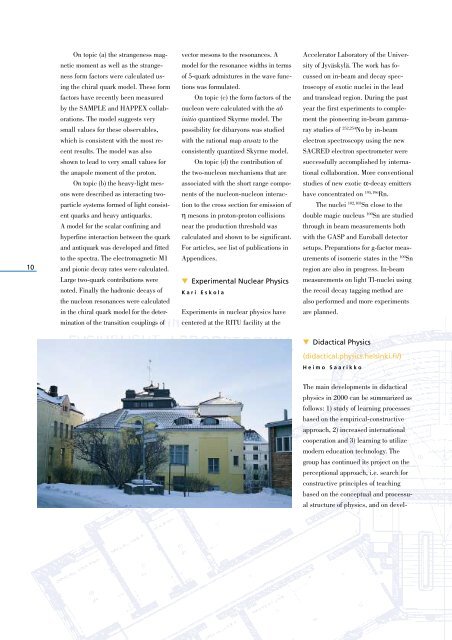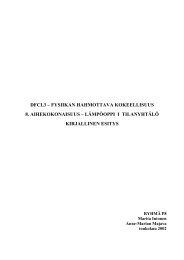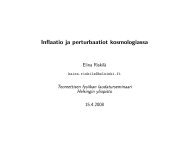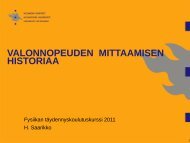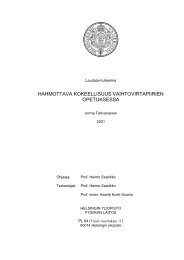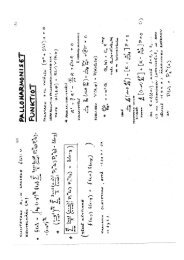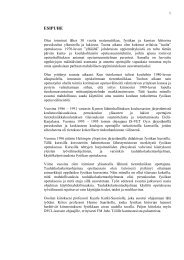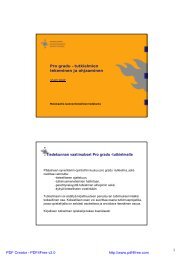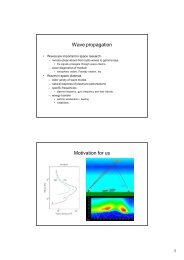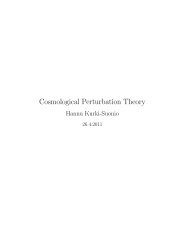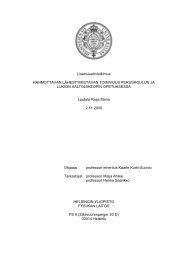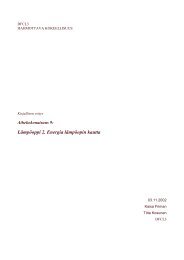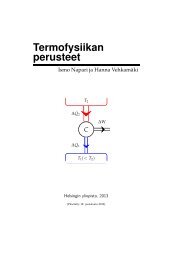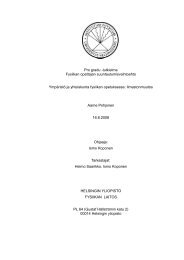Department of Physics annual report 2000 - Fysiikan laitos - Helsinki.fi
Department of Physics annual report 2000 - Fysiikan laitos - Helsinki.fi
Department of Physics annual report 2000 - Fysiikan laitos - Helsinki.fi
You also want an ePaper? Increase the reach of your titles
YUMPU automatically turns print PDFs into web optimized ePapers that Google loves.
On topic (a) the strangeness mag-<br />
vector mesons to the resonances. A<br />
Accelerator Laboratory <strong>of</strong> the Univer-<br />
netic moment as well as the strange-<br />
model for the resonance widths in terms<br />
sity <strong>of</strong> Jyväskylä. The work has fo-<br />
ness form factors were calculated us-<br />
<strong>of</strong> 5-quark admixtures in the wave func-<br />
cussed on in-beam and decay spec-<br />
ing the chiral quark model. These form<br />
tions was formulated.<br />
troscopy <strong>of</strong> exotic nuclei in the lead<br />
factors have recently been measured<br />
On topic (c) the form factors <strong>of</strong> the<br />
and translead region. During the past<br />
by the SAMPLE and HAPPEX collab-<br />
nucleon were calculated with the ab<br />
year the <strong>fi</strong>rst experiments to comple-<br />
orations. The model suggests very<br />
initio quantized Skyrme model. The<br />
ment the pioneering in-beam gamma-<br />
small values for these observables,<br />
possibility for dibaryons was studied<br />
ray studies <strong>of</strong> 252,254 No by in-beam<br />
which is consistent with the most re-<br />
with the rational map ansatz to the<br />
electron spectroscopy using the new<br />
cent results. The model was also<br />
consistently quantized Skyrme model.<br />
SACRED electron spectrometer were<br />
shown to lead to very small values for<br />
On topic (d) the contribution <strong>of</strong><br />
successfully accomplished by interna-<br />
the anapole moment <strong>of</strong> the proton.<br />
the two-nucleon mechanisms that are<br />
tional collaboration. More conventional<br />
On topic (b) the heavy-light mes-<br />
associated with the short range compo-<br />
studies <strong>of</strong> new exotic α-decay emitters<br />
ons were described as interacting two-<br />
nents <strong>of</strong> the nucleon-nucleon interac-<br />
have concentrated on 195,196 Rn.<br />
particle systems formed <strong>of</strong> light consist-<br />
tion to the cross section for emission <strong>of</strong><br />
The nuclei 102,103 Sn close to the<br />
ent quarks and heavy antiquarks.<br />
η mesons in proton-proton collisions<br />
double magic nucleus 100 Sn are studied<br />
A model for the scalar con<strong>fi</strong>ning and<br />
near the production threshold was<br />
through in beam measurements both<br />
hyper<strong>fi</strong>ne interaction between the quark<br />
calculated and shown to be signi<strong>fi</strong>cant.<br />
with the GASP and Euroball detector<br />
and antiquark was developed and <strong>fi</strong>tted<br />
For articles, see list <strong>of</strong> publications in<br />
setups. Preparations for g-factor meas-<br />
10<br />
to the spectra. The electromagnetic M1<br />
and pionic decay rates were calculated.<br />
Appendices.<br />
urements <strong>of</strong> isomeric states in the 100 Sn<br />
region are also in progress. In-beam<br />
Large two-quark contributions were<br />
noted. Finally the hadronic decays <strong>of</strong><br />
the nucleon resonances were calculated<br />
▼ Experimental Nuclear <strong>Physics</strong><br />
K a r i E s k o l a<br />
measurements on light Tl-nuclei using<br />
the recoil decay tagging method are<br />
also performed and more experiments<br />
in the chiral quark model for the deter-<br />
Experiments in nuclear physics have<br />
are planned.<br />
mination <strong>of</strong> the transition couplings <strong>of</strong><br />
centered at the RITU facility at the<br />
▼ Didactical <strong>Physics</strong><br />
(didactical.physics.helsinki.<strong>fi</strong>/)<br />
H e i m o S a a r i k k o<br />
The main developments in didactical<br />
physics in <strong>2000</strong> can be summarized as<br />
follows: 1) study <strong>of</strong> learning processes<br />
based on the empirical-constructive<br />
approach, 2) increased international<br />
cooperation and 3) learning to utilize<br />
modern education technology. The<br />
group has continued its project on the<br />
perceptional approach, i.e. search for<br />
constructive principles <strong>of</strong> teaching<br />
based on the conceptual and processual<br />
structure <strong>of</strong> physics, and on devel-


